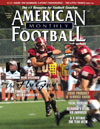AMERICAN FOOTBALL MONTHLY THE #1 RESOURCE FOR FOOTBALL COACHES
Article CategoriesAFM Magazine
|
The Fly GuyWillamette’s Mark Speckman mixes simplicity with complexity to produce big resultsby: Mike Kuchar Senior Writer, American Football Monthly © More from this issue Take one of your quicker athletes, start him in full motion before the snap, get him the ball as he hits top speed and let him run. Sounds simple? Hardly. Sure, on paper, the concept of the fly or jet sweep is elementary, but to run it effectively – that takes some precision. It’s a precision that has made Mark Speckman at Willamette College in Salem, Oregon his living as a head coach. He’s known around the country as “The Fly Guy” patterning his offense around the fly sweep – a scheme he’s been running for 29 years. Just this season, the Bearcats averaged 41.5 points per game en route to an 11-1 season and their first Division III playoff birth since 2004. It’s produced over 250 yards per game on the ground and 415 yards of total offense. Just for the formality of it, the “fly” is commonly known among other regions as the jet ....The full article can only be seen by subscribers. Subscribe today!
|
|
|||||||
| HOME |
MAGAZINE |
SUBSCRIBE | ONLINE COLUMNISTS | COACHING VIDEOS |
Copyright 2025, AmericanFootballMonthly.com
All Rights Reserved





